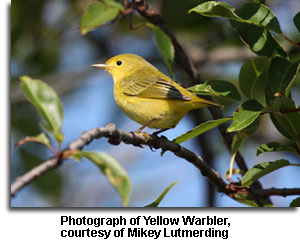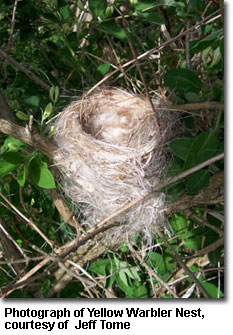Yellow Warbler
(Setophaga petechia)
 Description & Range:
Description & Range:
Yellow Warblers are small, brightly colored songbirds with thin, pointed bills. Their overall appearance is a bright yellow (hence, the name!). Males also tend to have chestnut streaks on their chests. Yellow Warblers use their thin bills to catch a variety of insect and spider species. However, in the fall and winter, they will also consume seeds and berries.
Yellow Warblers, like other warbler species, are Neotropical migrants. Neotropical migrants overwinter in places like Mexico, Central and South America before returning to points north in the early spring.
Habitat:
This species of warbler can be found in open woodlands throughout Maryland and nesting in shrubs during late spring and summer. Riparian woodlands and understory, swamp edges, parks, and gardens.
Diet:
Mainly insects, but will also eat fruit in fall and winter.
 Reproduction:
Reproduction:
Like many songbird species, nests of Yellow Warblers are often parasitized by Brown-headed Cowbirds. Brown-headed Cowbirds are brood parasites which lay their eggs in nests made by other bird species. Once the cowbird chicks hatch, Yellow Warblers or other parasitized bird species will feed and take care of the cowbird chicks at the expense of their own young. However, Yellow Warblers have a tendency to build a new nest right on top of the parasitized one! Sometimes these nests will consist of two to six tiers. After the female builds the nest, she will incubate the 4-5 eggs for approximately 11 days. Both parents feed the young. Once the chicks have hatched they fledge (leave the nest) in 9-12 days.
Sounds:
Yellow Warblers have a variable, high pitched call. The mnemonic for Yellow warbler song is “Sweet, sweet, sweet, I’m-so-sweet.”
Similar Species:
- Wilson’s Warbler
- Orange-crowned Warbler
Did you Know?
To attract Yellow Warblers and other warbler species to your yard, plant native shrubs and offer suet in early spring and the fall. Yellow Warblers prefer dense shrubs like alders and willows which are typically found in slightly wet environments. Suet is a great high-energy substitute for insects, and it can be smeared on a tree or placed in a suet cage. Warblers also prefer to have a running water source, such as a fountain. However, if you do not have a fountain, then a simple bird bath will do.